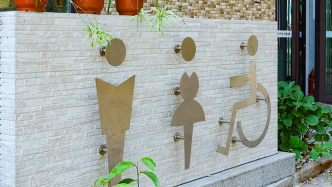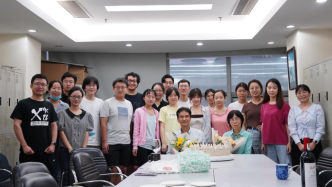
Editor's Note:This popular science article is supported by the Shanghai Municipal Science and Technology Commission (Project No.: 22DZ2304300), in collaboration with The Paper and "World Science," reporting on award-winning achievements recognized by the national and municipal science and technology awards.
This report centers on the 2022 Shanghai Science and Technology Award for Natural Science, which was awarded for the project "Molecular Pathology and Repair Mechanisms of Spinal Cord Injury." The project is led by Professor Cheng Liming, the chief physician at Tongji Hospital affiliated with Tongji University.

Orthopedic and Spinal Nerve Rehabilitation Team at Tongji Hospital
While a broken bone can be repaired using casts, what happens when the nerve tissue in the spinal cord is damaged?
In particular, what occurs when the "artery" responsible for signal transmission—the spinal cord—is injured? Are paralysis and immobility the only outcomes?
Continuing to focus on this challenging issue is Cheng Liming, chief scientist of the National Key Research and Development Program and deputy director of the School of Medicine and Life Sciences at Tongji University. He also leads the Key Laboratory of Spinal Cord Injury at the Ministry of Education.
In an exclusive interview with The Paper's technology division, he stated: "(Spinal cord injury) is akin to a fallen utility pole; it’s easy to prop the pole back up, but reconnecting the broken wires is quite an effort." He leads a team that has developed a novel comprehensive rehabilitation strategy and regeneration recovery system for spinal cord injuries.
The project "Molecular Pathology and Repair Mechanisms of Spinal Cord Injury," led by Cheng Liming, previously won the first prize in the Natural Science category of the 2022 Shanghai Science and Technology Award.
His research team discovered that microglia could likely become a new target for spinal cord injury repair. They improved materials that promote recovery through interdisciplinary collaboration and initiated the only clinical study in China, approved by the National Health Commission, on human neural stem cell transplantation for spinal cord injury.
Finding the Key Targets for Spinal Cord Injury Repair Amidst a "Black Box" of Pathology
The recovery and regeneration of spinal cord injury (SCI) remains a hot and difficult topic in regenerative medicine, and there is currently a lack of effective treatment and rehabilitation methods. SCI is characterized by high incidence rates, high treatment costs, high disability rates, and low onset ages. The "2023 Report on the Quality of Life and Disease Burden among Spinal Cord Injury Patients in China" shows that as per previous research data, there are 3.74 million existing spinal cord injury patients in China, with around 90,000 new patients added each year.

Research papers revealing molecular pathology mechanisms of spinal cord injury published in Cell and STTT journals
The recovery of neurological function after spinal cord injury depends on the integrity and plasticity of neural circuits. The rupture of neuronal axons and the death of neurons can disrupt neural circuit functionality, thus, the plasticity of neural circuits forms the basis for neurological recovery.
However, after spinal cord injury, endogenous neural stem cells and immune cells are activated in large numbers, and the pathological process is exceptionally complex, making the remodeling of neural circuits particularly challenging. "Damage to the central nervous system (CNS), including the spinal cord, typically leads to permanent impairments in sensory, motor, and autonomic functions, and until now there are no effective treatment methods. The pathological mechanisms of SCI resemble a 'black box,' which remains unclear to this day," Cheng Liming remarked. Moreover, the roles of different types of cells in SCI, such as immune cells, astrocytes, and microglia, are still debated.
Cheng Liming commented that extensive previous research indicates that the challenge lies in how to improve the microenvironment of the injury area to facilitate neuronal regeneration and functional remodeling. "Currently, our understanding of the injury microenvironment following spinal cord injury is also quite limited; gaining detailed insights into these processes may help develop optimal treatment strategies targeting different pathological processes."
With the support of the "Regeneration and Repair of Spinal Cord Injury" Key Laboratory under the Ministry of Education, alongside national key research and development initiatives and international (regional) co-projects from the National Natural Science Foundation, Cheng Liming commenced his research.
Recent studies have discovered that interneurons may provide bridges for both proximal and distal neurons, forming new neural circuits, which has become a primary research focus for spinal cord injury repair. These key interneurons may derive from progenitor interneurons in the spinal cord, transplanted stem cells, or neurons, astrocytes, and oligodendrocytes differentiated from endogenous neural stem cells.
The research team conducted population sequencing (39 tissue samples) and single-cell sequencing (59,558 cells) analysis on the spinal cord tissues of male and female adult mice at various time points post-injury and found that most molecular pathological dynamic changes occurred in major cell types of spinal cord tissue, including neurons, microglia, astrocytes, and endothelial cells.
Data indicated that various subtypes of microglia and astrocytes already existed in the uninjured spinal cord, and these subtypes rapidly underwent phenotypic changes after injury. Interestingly, while fluctuations in many other cell types often return to an uninjured state, microglia seem to permanently switch to different transcriptional states, leading to more protracted changes in the spinal cord's immune microenvironment.
Additionally, the research team identified a microglial subtype with features that promote regeneration in newborn mice following spinal cord injury, although subtle differences in gene expression were noted compared to newborn mice. Altering these subtle differences may aid in spinal cord repair.
"This suggests that microglia could likely become new targets for spinal cord injury repair," Cheng Liming said.

Professor Cheng Liming
Finding Ways to Illuminate the 'Tree of Life'
Another key to the problem is how to "light up" these crucial cells to promote neuronal regeneration and recovery.
Identifying suitable materials to activate these cells is essential. Cheng Liming explained: "Much like the 'Tree of Life' in the movie 'Avatar,' where deceased organisms are connected to it and can gain new life, we are searching for such materials."
In the broader context of "medical-engineering cross-disciplinary collaboration," Cheng Liming teamed up with nanobiomedicine experts from Tongji University to co-develop a biodegradable layered double hydroxide (LDH) nanomaterial—LDH-NT3—that can modulate the immune cell profiling at the injury site and suppress inflammatory responses.
Specifically, this material exhibits dual functions for neuro-immunity, significantly promoting the migration and neuro-differentiation of neural stem cells (NSCs), activating L-Ca2+ channels, and inducing action potentials. The research team has proposed a spinal cord repair strategy that utilizes this material to activate the target TGFBR2 and co-regulate neural stem cells and microglia.
The researchers formulated a nano-composite system LDH-NT3 by loading LDH with the neurotrophic factor NT3 and implanted it into the spinal cord injury area of mice, where endogenous neural stem cells and functional neurons were observed to regenerate in the injury site, leading to significant improvements in behavioral and electrophysiological evaluations of the spinal cord injury mice. Cheng Liming stated, "The LDH material itself promotes nerve regeneration, and by modifying it, we have created a superior material, LDH-NT3, that shows enhanced efficacy for spinal cord injury repair compared to LDH."
"We are also undertaking a series of preparatory works. I do not know when this achievement will reach clinical application; it may be soon or may take a lifetime of effort. But that is the essence of scientific research," Cheng Liming concluded.

Professor Cheng Liming guiding spinal cord injury patients in rehabilitation training
In October 2022, Cheng Liming held face-to-face discussions with two patients who underwent spinal cord transplants. They participated in a clinical trial project led by Cheng Liming and approved by the National Health Commission—the evaluation of the safety and preliminary efficacy of human neural stem cell transplantation for spinal cord injury, which is currently the only human neural stem cell transplantation clinical research authorized by the National Health Commission for spinal cord injury as of this writing. Both subjects showed improvement in their spinal cord recovery following rehabilitation and stem cell treatment.
"The ocean of knowledge is infinite. My team and I are fortunate to uncover a glimpse of the secrets of spinal cord treatment. As a clinician, satisfying unmet clinical needs is my greatest wish, so my future focus will continue to center on relevant basic research and expedite the clinical translation of existing findings," Cheng Liming remarked.


